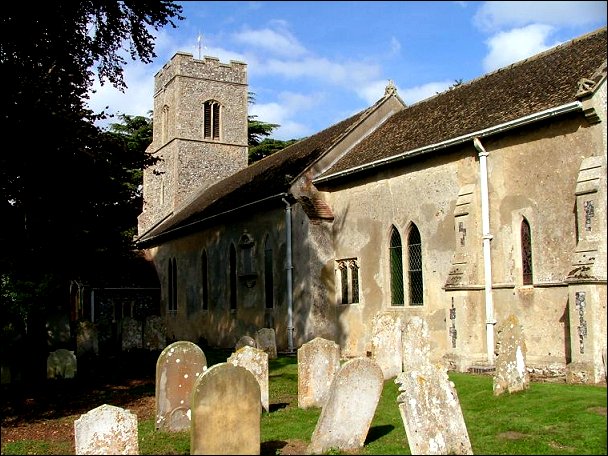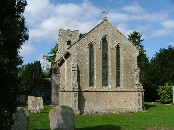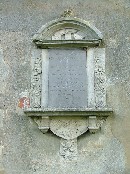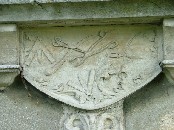| |
|
Holy
Cross, Stoke Holy Cross
 |
|
Here
we are again south of Norwich, and the beautiful
blue skies of Historic Churches bike ride day
2006. We had come on four wheels rather than two,
for reasons that will become obvious. We were men
on a mission. After Burgh, Stoke is the
most common placename in East Anglia, and so it
is usually qualified with reference to the
nearest town, or to the dedication of the parish
church. By a happy accident, this Stoke has a
church with one of the prettiest dedications that
there is. Perhaps the very words Holy Cross
serve to remind to us of the recent protestant
past of this nation, because most languages do
not have separate words for Holy and Saint.
In most languages they are the same.
|
Medieval
East Anglians would have seen the Cross and figures like
the Blessed Virgin and St Edmund and as all being part of
the same firmament of holiness, and equally efficacious
for intercessionary prayer. For protestants, Saints were
more like shining examples of goodness to be followed,
and the same could not be said of a piece of wood.
Stoke Holy
Cross is outer Norwich suburbia, just beyond the pale
boundary of the A47. But as busy as the village is, the
pretty church of Holy Cross is set out in the fields on
the way to Shotesham, a kind of gateway to that delicious
part of south Norfolk that is rolling valleys and narrow
crooked lanes. It is a difficult church to date; the
chancel is obviously Early English, but it seems that all
the window tracery in the nave was renewed in a voracious
restoration of the 1870s.
We came
here on bike ride day, because, sad to relate, Holy Cross
is one of East Anglia's fortress churches. These are the
tiny handful that are kept locked without a keyholder
notice. There are not many of them, but they tend to
cluster together, and there are several immediately to
the south of Norwich. But, as with most of them, if you
visit on bike ride day you usually find that the
custodians are warm, welcoming people who are happy for
you to see the inside of their church. The woman on duty
here was so friendly that I decided to broach the
difficult question: exactly why did the parish
of Stoke Holy Cross not allow access to visitors? The
answer, rather sadly, was that that she had not realised
that most Norfolk churches are open every day. She had
assumed that they were all kept locked. This in itself is
not a reason for locking, but may explain the seige
mentality of parishes like this one.
Perhaps
the most unusual features of Holy Cross can be seen from
the outside in any case. These are a 15th century font,
which is leaning up against the south-west corner of the
nave, and appears to have been there for a century or
more, and the wall monument to Thomas Havers, Theologian,
Doctor and Surgeon, which includes the tools of his trade
in relief, including, I was pleased to see, a lancet, a
non-identical twin to the single lancet in the south
chancel wall, if you like.
You step
into a church which bears the marks of a heavy 19th
century restoration, but one which has left it looking
trim rather than anonymous. There is one of those war
memorials which you see several places in Norfolk, a
painted triptych with St George and St Michael flanking
the names in the middle. The pulpit is rather dramatic,
with a highly polished copper relief depicting the
Blessed Virgin and child.
| This
is not a big church, and the triple lancet east
window might have left it feeling claustrophobic;
but the walls are painted white and there is some
very good late 19th and early 20th century glass,
a perfect setting for it. The best is probably
the sequence of Faith, Hope and Charity in the
north and south walls of the chancel, but my
personal favourite is the Road to Emmaus in the
nave, which must be by the same artist as the
angels at Walsoken. The
Annunciation in the chancel is early 20th
century, and has a Comperish feel, and of the
scenes from the life of Christ the best is
probably the Adoration of the Shepherds, a scene
which always has a particular resonance when
found in a rural Norfolk church. It is only a
shame that so few people are able to benefit from
the pleasures on offer here.
|
|
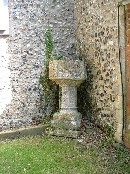 |
|
|
|

